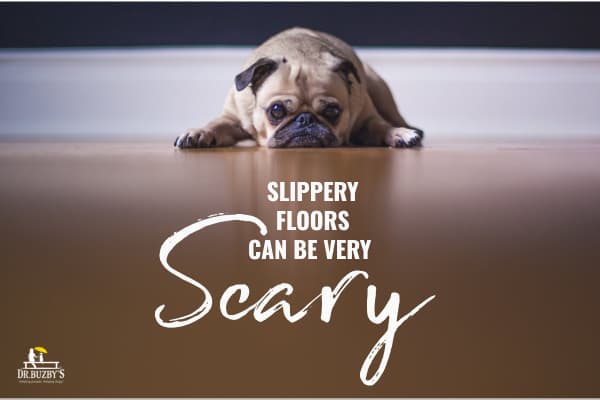Dogs rely on their claws to dig into surfaces like cleats. Slippery flooring presents a challenge, and they end up walking like Bambi on ice.
I have a one-year-old Chocolate Lab that is scared of floors. She will sit in a crate crying, wanting to be with me, but refusing to come out. When she digs her claws in to gain traction, it seems to make things worse. Her nails and the tufts of fur between her paws are trimmed. I have placed mats around the house, but she has no confidence in them. Scattering treats over the floor has not worked. How can I help her feel more comfortable?
Slippery flooring challenges many dogs. They end up walking about like Bambi on ice.
Usually dogs rely on their claws to dig into surfaces like cleats. Leggy pets and those with mobility issues seem to suffer the most. Sometimes it can take only one tumble to shake a dog’s confidence and instil fear.
Some owners strategically place rugs and runners to give the pet a means of getting from one area of the home to another. These do need to be secure so that they do not slide as the dog tries to navigate them.
This temporary solution allows time for deliberate training. Dogs learn to step out onto floors at their own pace. For example, owners can first reward the dog for placing one paw on the floor. Once the dog understands this action, they are rewarded for placing two paws onto the floor. Two paws leads to three and then all four. Standing then leads to walking.
Train slowly and carefully. Fear can trigger scampering, which in turn can cause the dog to slip, reconfirming fear. Assistive devices such as Dr. Buzby’s toe grips (toegrips.com) can help prevent accidental slips and falls.
Toe grips are rubber rings that fit over the dog’s claws. As the dog instinctively digs into the floor, the rubber provides traction. Much needed support boosts confidence. The difference is similar to wearing stilettos on icy streets compared to wearing rubber-soled boots.
Many owners report an immediate noticeable improvement. Toe grips travel with the dog, giving the pet full access to all areas of the home and full control of their own stability.
However, dogs that have developed a strong conditioned fear response may need a combination of toe grips and a reward-based program. Food rewards provide the incentive to try navigating the floor one more time. Once confidence builds, fear diminishes.
We have a six-year-old neutered male toy breed dog that marks various items in the house. Some people say it might be anxiety-related. What causes this and how do we stop it?
Medical conditions, anxiety, long-standing habits and the need to make a place feel like home can trigger marking. The first course of action is to look for underlying medical problems.
Once health matters are ruled out, create an environment with strict supervision. Prevent marking from happening. Habits take time to form and they take time to break. When unable to supervise, confine the dog to prevent it from practicing the behaviour.
At the first sign of sniffing, take the dog outside. Encourage it to mark outside on bushes, trees and posts.
Offer food throughout the home. Many dogs dislike marking in areas in which they eat. By feeding everywhere, you are creating an environment where the whole house is an eating area rather than a place to mark.
Finally, watch for things that trigger anxiety or reward misbehaviour. Something as minor as dogs passing by the home can agitate some pets. Others will mark because the attention that comes from owners, while negative, is still attention the dog seeks to obtain.
Yvette Van Veen is an animal behaviour consultant. Write her at [email protected]
Anyone can read Conversations, but to contribute, you should be a registered Torstar account holder. If you do not yet have a Torstar account, you can create one now (it is free)
RegisterConversations are opinions of our readers and are subject to the
Senior and special needs dogs are especiallyprone to slipping
I’m not saying slipping isn’t dangerous for dogs of all ages, but usually young dogs can compensate. If they slip and slide on hardwood floors, they have the balance, the muscle strength, and tendon and ligament function to avoid wiping out.
However, this may not be the case for older dogs. Much like older people, our grey-muzzled companions often lack balance, their reflexes aren’t as sharp, and their muscles are atrophied. This puts these dogs at a real disadvantage in their struggle against gravity.

Additionally, senior dogs have more difficulty going from a lying down to standing position. Slipping during the act of rising compounds the problem by several magnitudes. When these dogs sense that they are falling and try to “catch” themselves, they can be injured in the struggle to stay upright.
If your dog is living in fear of hardwood floors help is here
SUMMARY: Is your dog afraid of hardwood floors? Dogs who are slipping on smooth surfaces live in fear. So much so, that the dogs’ fear of walking from point A to point B in their homes can affect the way they interact with their families. Learn why dogs are fearful of hardwood floors and get five practical solutions from integrative veterinarian Dr. Julie Buzby.

Are hardwood floors and smooth surfaces fear-inducing for your dog? If this is the case, let’s dig into understanding how a dog’s fear of hardwood floors changes daily routines, lowers confidence, takes a toll on the dog’s body, and clearly impacts quality of life.
Dog with hardwood floor phobia | Redeeming Dogs | Flower Mound dog training
Q I need help with a 1-year-old beagle mix who has suddenly become afraid to walk on tile. She whines in a room or hallway until you go and get her. I have tried rugs, but that has not worked, and treats, which work fairly well, but I have to go get her. I am buying a pair of shoes for her to try, but I know she won’t want to keep on. I am afraid of the paw wax as I don’t need to fall myself. I am 67. My veterinarian recommended Xanax for her, and she seemed better, but still whined a lot. I feel badly for her.
A I am glad you ruled out health problems first. If your beagle was older, my first concern would be an undiagnosed orthopedic problem. But your dog is young, and since this is a sudden change in behavior not related to a health problem, your dog probably had a slippery experience on the floor that has shaken her courage. She may have even fallen.
Get ready for the weekend with our picks on where to shop, dine and have fun on Long Island.
For some dogs, walking on a slick wood or tile floor may feel like walking across a sheet of ice: You can’t get your grip and you feel like you’re going to fall. The uncertainty of that experience may be what’s causing her whining. She wants to cross the room, but doesn’t trust the floor anymore, so she whines to express her anxiety and frustration to you.
The anxiety medication can help reduce her unease, but she will still need to build her trust with the floor again. The best way to do that is to replace that memory with a more positive experience. That might involve putting treats across the floor or giving her a puzzle toy or Kong with treats to play with in that area. The goal is to keep her mind busy on or near the floor. It’s like chatting with someone on an airplane to keep their mind off their fear of flying.
At this point, any movement under her feet, whether a slippery floor or bunched up rug, will only increase her anxiety. Keep her nails trimmed, so her paws can better grip the floor, and try rugs again, but this time, make sure they are weighty or have special padding, so they don’t bunch up.
Q. My veterinarian has been trying to help keep my dog from constant scooting since age 4. She is more than 13 years old and still does it, fussing and whining because her anal sacs are irritated. The veterinarian empties the sacs, as needed. I add fiber products in her wet food as advised by my vet. She only eats wet food. I need your advice. She is overweight, which does not help.
A Dogs and cats often butt-scoot across the lawn or carpet to relieve posterior discomfort, which can be the result of worms, skin allergies or impacted anal glands. The primary culprit is impacted anal sacs, which, as you know, can become chronic for some dogs.
I trust your veterinarian has been giving you good advice, so I will just add a few things here. While your veterinarian or groomer can empty the glands as needed, the glands also can be surgically removed as a last resort.
Keeping your dog fit helps, since fatter dogs tend to have the problem more often. There are some good canine weight-loss foods on the market that you can try.
There is also a product called NaturVet No Scoot Plus Pumpkin Soft Chews for Dogs, which supposedly “supports healthy anal sac and gland function.”
Q In my daily walks in my neighborhood, I’ve noticed an increase in the number of wild rabbits. They are especially numerous early mornings and evenings. Is there an explanation for the rise in their population?
A I checked with Volunteers for Wildlife in Locust Valley. The group is unaware of any large population boom of rabbits on Long Island. As prey animals, the population of rabbits in a certain area is in flux with the number of predators in that area. They say you are likely in an area that is hospitable to wild rabbits, providing an abundance of grass and clover, places to hide and few natural predators.
The most common times to see wild rabbits are in the morning and evening, so enjoy.